8 questions to ask before your next CE class



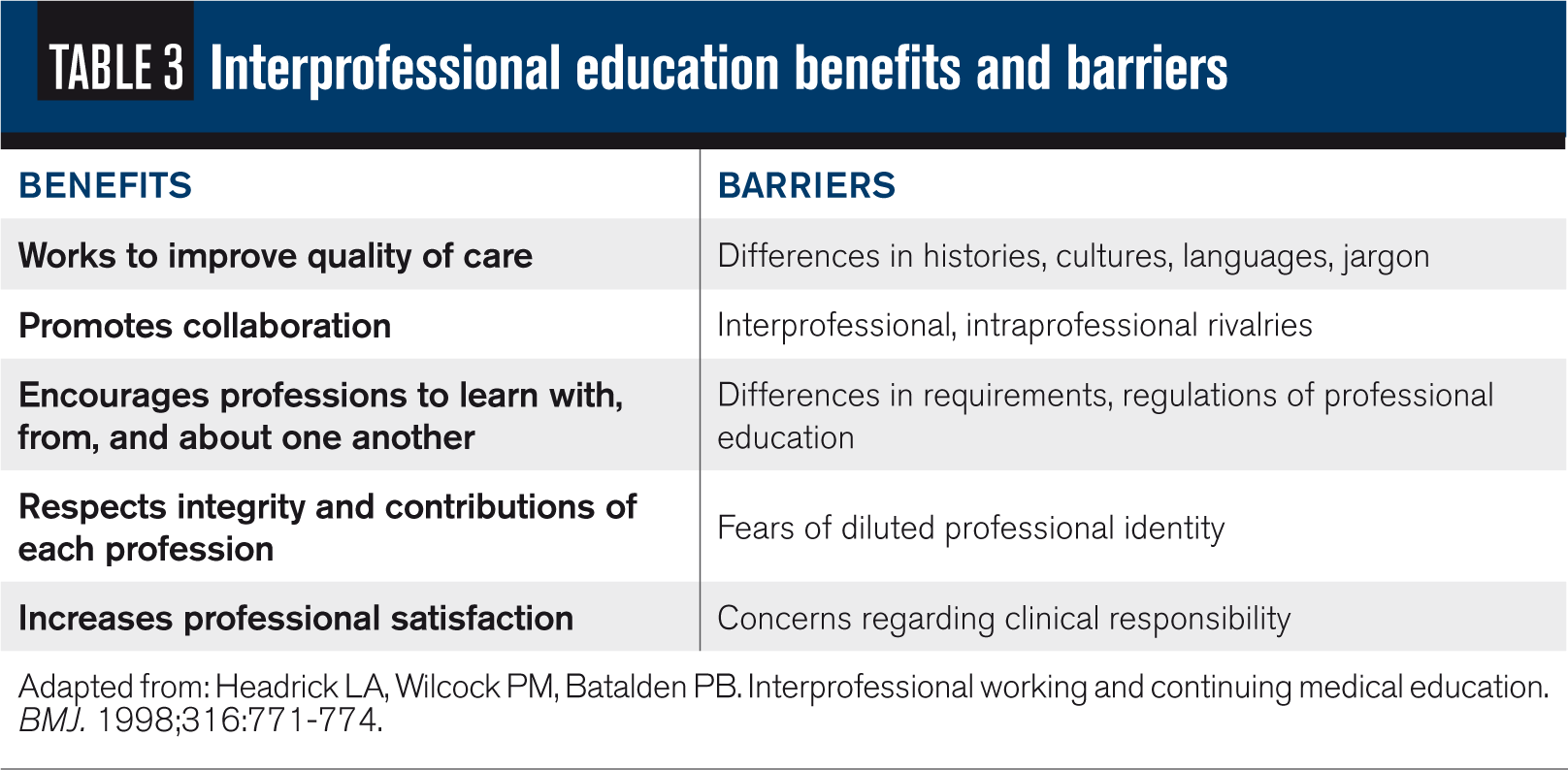
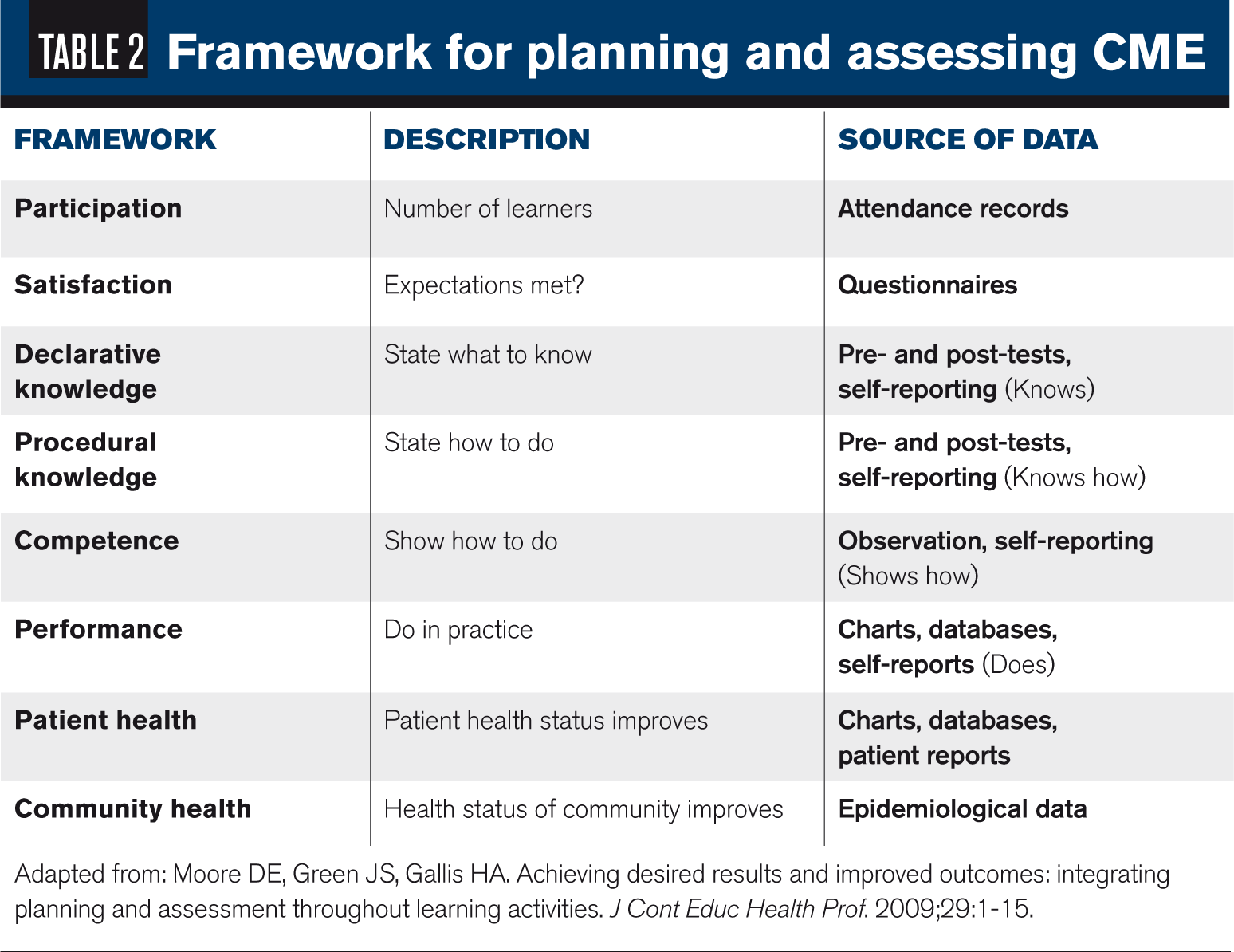

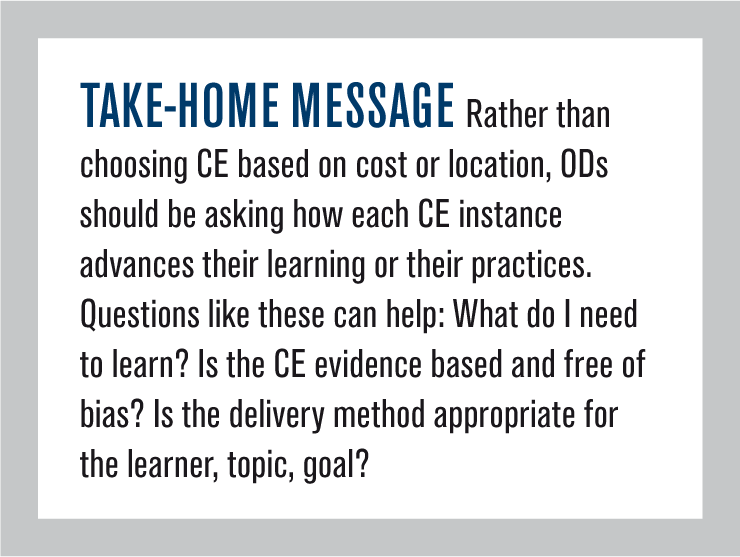
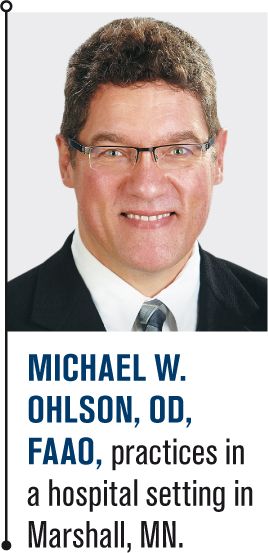
Optometrists choose continuing education (CE) for a variety of reasons, all of which have merit. (See box for a list of common factors.) Rather than choosing CE based on cost or location, ODs should be asking how each CE instance advances their learning or their practices.
Traditionally, CE requires mandated “seat time” or passive education. Doctors travel to meetings for live lectures, listening to topics and speakers selected by meeting committees. These events allow access to topical information, pleasant and useful interaction with lecturers and colleagues, contact with vendors in exhibit halls, and attendance in meetings held for other purposes.
Regulatory agencies require a number of hours to be completed over one to three years, depending on state scope of practice. Some states require ODs attain CE on certain topics, such as ethics, dependent abuse, ocular disease, and other categories. Credentialing entities (certifications) and institutions often require other specified or additional hours of CE; such hours may or may not cross over to licensure requirements, an understandable concern for physician learners.
ODs should ask these eight questions before signing up for CE.
1. What do I seek to learn?
Optometric practices can vary dramatically in practice setting, patient populations, and doctor interests or specializations. This breadth of care provides richness and variety to our practices.
However, such developments necessitate a variety of curricula aimed at specified target audiences. Individual interests and concerns vary as well. A doctor seeking new information on pediatrics and vision therapy may be poorly served by attending 20 hours of CE devoted to contact lenses and disease, for example, if the goal is only to punch a paper card.
2. What do I need to learn?
The obvious answer is that doctors need to attain knowledge and skills relevant to their individual practices; however, it can be problematic to effectively address such needs.
While physician learners strongly believe they can correctly assess their own weaknesses and strengths, research demonstrates that to be unlikely; a systemic review found that physicians are quite limited in their abilities to self-assess competencies.1
In addition, those physicians performing the least well via external assessment generally assess their competencies with the least accuracy, an inverse relationship.2 Lately, physician learning efforts are evolving toward increasing self-awareness, better educational techniques, and a focus on outcomes.3
Although negligence and malpractice are low occurrences in optometry,4 the profession’s systemic nature of care and expanding scopes of practice require awareness of trends in continuing professional development, educated reflection, and professional behaviors/strategies.
ODs are held to medical standards of care for diagnosis and treatment. Thus, strong knowledge and performance in practice is required with regard to clinical optometry, systemic disease, ocular disease, and principles of diagnosis.
In addition, ODs in academic and healthcare institutions can benefit from CE aimed at creating change, such as engaging clinicians and staff in organizational priorities, functional team-building, and increased well-being.5
Previously from Dr. Ohlson: Knowing the OD's role in substance abuse
3. Is the CE evidence based and free of bias?
Evidence-based medicine (EBM) has become a common paradigm in health care. However, the idea of practice based on research-based evidence free of bias is straightforward.
While EBM can present dilemmas, such as misappropriations or distortions via other interests, overestimations of potential treatment benefits via trial design, or overemphasis on algorithmic rules, it’s likely the focus on high-quality evidence will continue.6
In primary care, Ebell found 18 percent of recommendations to be based upon high-quality, patient-oriented (improved health outcomes, morbidity, mortality, quality of life, symptom reduction) evidence.7
In eye care, Lai et al found that randomized controlled trial (RCT) evidence supported about 43 percent of ophthalmology interventions.8
Concern for rational thought and elimination of bias is not unreasonable. In the U.S., only about 55 percent of needed care is delivered, while 30 percent of services are deemed unnecessary; physician decision-making plays a significant role in costs.9
Even when RCTs contradict highly-cited observational studies (such as vitamin E for cardiovascular disease), changes in practice can be slow due to defense of the observational associations, delays in reduction of citations, or favorable citations of the contradicted articles (“wish bias”).10
4. Is the CE free of industry influence?
Removing commercial influence from CE would appear to be common sense, but many regulatory agencies accept unaccredited CE with assumptions of quality. Such decisions may be unwise in an era of accountability, transparency, and high expectations. The literature describes the effectiveness of CE on the alteration of physician prescribing habits.11
The public, physician leaners, and the profession do not benefit from a lack of standards for commercial support of CE. The Senate Finance Committee Report of 2007, critical of medicine’s continuing medical education (CME), specified expectations for commercial support.12 CME/CE accreditation entities of medicine, followed by nursing, pharmacy, and optometry, implemented revised or new standards for commercial support of CME/CE shortly thereafter.
This common interprofessional standard has also gained international recognition with the standards for commercial support having been adopted by accreditors in Europe, Canada, Oman, and Qatar.13
5. Is the delivery method appropriate for the learner, topic, goal?
Lectures offer convenience, and this method will likely continue as an element of CE. However, learning procedures requires supervised practice. For topics such as scleral contact lenses, vision therapy, lasers, gonioscopy, and scleral depression, there is no substitute for supervised training, demonstrating competency, and following up with performance in practice.
Online learning may be a viable method for CE. Casebeer found that physicians participating in online, case-based, interactive were more likely to make evidence-based clinical choices than non-participants.14 A pilot study using a needs-based, online module on managing hand trauma appeared effective at increasing knowledge.15 Ryan reported that online CME appeared equally effective as face-to-face delivery in the treatment and management of opioid dependence given the utilization of sound educational principles.16
6. How do I learn?
According to Knowles’ six principles, adult learners:17
• Are results-oriented
• Are autonomous and self-directed
• Need to connect life experiences and knowledge to the new content
• Require motive or need to learn
• Learn best with realistic or real-life contexts
• Are best motivated when they can solve significant problems in their work
ODs would certainly fall into this category of learner. Along these lines, self-directed learning in the clinic via point-of-care information services (such as UpToDate or eMedicine) may have promise for a differing type of learner-centered, effective CE.18
7. Is the CE effective in increasing knowledge, performance in practice, patient outcomes?
Simple information transfer does not represent the goal of modern CE. The Internet provides quick access to information to both physicians and patients. In addition, the amount of medical literature is growing at an exponential rate; keeping up on mere information may be impossible. While the time to double medical knowledge in 2010 was estimated at 3.5 years, the doubling time may be 73 days by 2020.19
Related: The importance of discovering your professional purpose
To be effective, CE should be based upon well-designed educational needs assessments of target audiences via discrepancy or “gap” analysis (current conditions, topics, or dilemmas in practice vs. the ideal practice or situation).20 Several trends are consistent in the literature.
The evidenced-based educational guidelines of the American College of Chest Physicians recommended live and multimedia approaches with multiple instructional techniques and multiple exposures to improve practice performance; single print media was found to be ineffective.21
Cervano and Gaines stated that CE could be effective in improving physician performance and patient outcomes when the activities are interactive, involve multiple exposures, take place over time, and are focused on outcomes considered important by physicians.22
To assure ongoing competence, performance, and improved patient health, Moore et al developed an approach for CME/CE providers using integrated and continuous planning and assessment focused on outcomes, recognizing the importance of engaging learners, reinforcing activities and materials, and developing a supportive framework to develop skills.23
In addition, an outcomes framework for CME planning and assessment has been formulated (Table 2). This learner- and outcomes-based approach has become the standard for CME/CE in medicine, pharmacy, nursing, and other medical specialties. In short, CE should be focused on the achievement of attaining specified, desired, positive outcomes.
8. Is the CE team based?
The current trend of interprofessional collaboration (IPC) may provide an opportunity to further such recognition while improving patient outcomes, bettering public health, and decreasing costs. Improved communication and teamwork, good working relationships, coordination of care, and patient-centered approaches are trends unlikely to diminish.
This development has barriers and well as positives (Table 3).
Looking ahead
The accredited CE of optometry is evolving along with the CME/CE of other healthcare professions.
Since the implementation in 1993 of the Council on Optometric Practitioner Education (COPE) Standards for Commercial Support of Optometric Continuing Education, two other notable accomplishments have occurred.
In 2017, COPE was recognized for substantial equivalence with the accredited CME of the Accreditation Council for Continuing Medical Education, an important step for optometry.
In 2018, COPE was included in Joint Accreditation for Interprofessional Continuing Education, alongside medicine, nursing, pharmacy, and physician assistants. This provides unified application processes and accreditation standards to CE providers, the opportunity to learn with, from, and about other professions to enable collaboration among all learners, and improved health care delivery and outcomes to patients.
There is little doubt that the opportunities of more effective and interprofessional CE involve new challenges for stakeholders such as physician learners, CE providers, and regulatory agencies. As an aspect of professionalism, all ODs have the duty to take active roles in their continuing competence and a reflective attitude toward contemporary CE.
Disclosures:
Dr. Ohlson practices in Minnesota with Avera Medical Group and across Iowa as the low vision consultant to the Iowa Educational Services for the Blind & Visually Impaired. He maintains Diplomate status in the Comprehensive Eye Care Section of the American Academy of Optometry and certification by the American Board of Certification in Medical Optometry. He enjoys spending time with his wife Joleen and their daughter Samantha.
References:
1. Davis DA, Mazmanian PE, Fordis M, Van Harrison R, Thorpe KE, Perrier L. Accuracy of physician self-awareness compared with observed measures of competence: a systemic review. JAMA. 2006 Sep 6;296(9):1094-102.
2. Leopold SS, Morgan HD, Kadel NJ, Gardner GC, Schaad DC, Wolf FM. Impact of educational intervention on confidence and competence in the performance of a simple surgical task. J Bone Joint Surg Am. 2005 May;87(5):1031-7.
3. McMahon GT. What do I need to learn today?--The evolution of CME. N Engl J Med. 2016 Apr 14;374(15):1403-6.
4. Duszak RS, Duszak R Jr. Malpractice payments by optometrists: an analysis of the national practitioner databank over 18 years. Optometry. 2011 Jan;82(1):32-7.
5. McMahon GT. The leadership case for investing in continuing professional development. Acad Med. 2017 Aug;92(8):1075-1077.
6. Greenhalgh T, Howick J, Maskrey N, Evidence Based Medicine Renaissance Group. Evidence based medicine: a movement in crisis? BMJ. 2014 Jun 13;348:g3725.
7. Ebell MH, Solol R, Lee A, Simons C, Early J. How good is the evidence to support primary care practice? Evid Based Med. 2017 Jun;22(3):88-92.
8. Lai TY, Wong VW, Leung GM. Is ophthalmology evidence based? A clinical audit of the emergency unit of a regional eye hospital. Br J Ophthalmol. 2003 Apr;87(4):385-90.
9. Djulbegovic B, Elqayam S, Dale W. Rational decision making in medicine: implications for overuse and underuse. J Eval Clin Pract. 2017 Dec 1.
0. Tatsioni A, Bonitsis NG, Ionnidis JPA. Persistence of contradicted claims in the literature. JAMA. 2007 Dec 5;298(21):2517-26.
1. Wazana A. Physicians and the pharmaceutical industry: is a gift ever just a gift? JAMA. 2000 Jan 19;283(3):373-80.
2. U.S. Senate Committee on Finance. Report to the Chairman and Ranking Member. Use of Educational Grants by Pharmaceutical Manufacturers. Available at: www.documentcloud.org/documents/2287688-u-s-senate-committee-on-finance-april-2007-staff.html Accessed 05/09/18.
3. McMahon GT. Independence from industry cannot be compromised. J Eur CME. 2017 Sep 19;6(1):1393296.
4. Casebeer L, Engler S, Bennett N, Irvine M, Sulkes D, DesLauriers, Zhang S. A controlled trial of the effectiveness of internet continuing medical education. BMC Med. 2008 Dec 4;6:37.
5. William JG. Are online learning modules an effective way to deliver hand trauma management continuing medical education to emergency physicians? Plast Surg (Oakv). 2014 Summer;22(2):75-8.
6. Ryan G, Lyon P, Kumar K, Bell J, Barnet S, Shaw T. Online CME: an effective alternative to face-to-face delivery. Med Teach. 2007 Oct;29(8):e251-7.
7. VanNieuwenborg L, Goosens M, De Lepeleire J, Schoenmakers B. Continuing medical education for general practitioners: a practice format. Postgrad Med J. 2016 Apr;92(1086):217-22.
8. Moja L, Kwag KH. Point of care information services: a platform for self-directed continuing medical education for front line decision makers. Postgrad Med J. 2015 Feb;91(1072):83-91.
9. Densen P. Challenges and opportunities facing medical education. Trans Am Clin Climatol Assoc. 2011;122:48-58.
20. Norman GR, Shannon SI, Marrin ML. The need for needs assessment in continuing medical education. BMJ. 2004 Apr 24;328(7446):999-1001.
2 . Davis D, Galbraith R; American College of Chest Physicians Health and Science Policy Committee. Continuing medical education effect on practice performance: effectiveness of continuing medical education: American College of Chest Physicians Evidence-Based Educational Guidelines. Chest. 2009 Mar;135(3 Suppl):42S-48S.
22. Cervero RM, Gaines JK. The impact of CME on physician performance and patient health outcomes: an updated synthesis of systematic reviews. J Contin Educ Health Prof. 2015 Spring;35(2):131-8.
23. Moore DE Jr, Green JS, Gallis HA. Achieving desired results and improved outcomes: integrating planning and assessment throughout learning activities. J Contin Educ Health Prof. 2009 Winter;29(1):1-15.
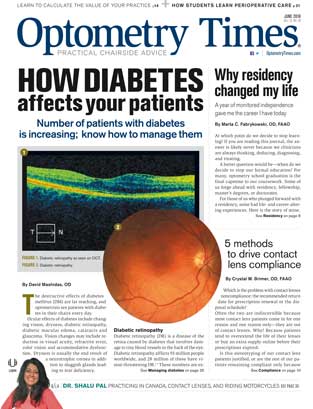
Newsletter
Want more insights like this? Subscribe to Optometry Times and get clinical pearls and practice tips delivered straight to your inbox.